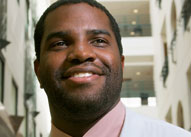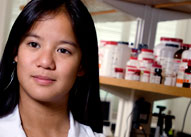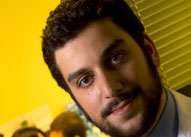

| Fall 2008 | ||||||||||||||||||
| Current Issue | ||||||||||||||||||
| Making better doctors Food fight One of them What our vision means for you Moving forward Clinical care From the Executive VP |
||||||||||||||||||
| Past Issues Other Publications Contact Us Make a Gift WHSC home |
||||||||||||||||||
|
||||||||||||||||||
Teaching values in medicine is something that’s caught, not taught. A new approach at Emory is molding students into the best doctors they can be.
By Valerie Gregg • photographs by Jack Kearse
“I was still on very shaky legs at that point,” she says, now beginning her second year at the Emory School of Medicine. “It was very real, intense, and nerve-wracking. I had to call my mom afterwards.”
Luckily, the “patient” was a completely healthy actor, one of several the school hires to play patients stricken by a variety of illnesses and disorders to help students practice their clinical skills.
Ryder’s HIV-positive patient returned the next week and once again blew her mind. This time, after she reviewed test results with him—viral load, immune cell counts, and other indicators of how well his body was fighting the virus, he asked for Viagra.
“It sure surprised me,” she says. “But I got a grip on myself pretty quickly. I knew I had to be open-minded. He had a low viral load, his disease was well controlled, and he had a strong health care team that he saw consistently. Using condoms, he should be able to have a sex life. I had to be nonjudgmental and open to his needs.”
This time she called her mother brimming with pride and excitement over a job well done. “I told my mother that this experience was making me a more compassionate person,” she says. “It was a powerful moment for me. I realized this is what practicing medicine is about. Medical school is first and foremost about learning to take care of people.”
Ryder is a member of the class of 2011, the first class at Emory’s medical school to experience a dramatically revamped curriculum aimed at meeting the changing, and challenging, needs of health care today. Since the day of that first HIV diagnosis, Ryder has earned a wealth of confidence in her abilities as a diagnostician, caregiver, and doctor-to-be.
“I have learned so much in a year that it boggles my mind,” she says. “There has been so much medical language, science, and process in terms of patient care to learn. I really don’t know how I’ve absorbed it all, but I have. The only explanation is that the manner in which we’ve been taught has been extremely efficient and effective.”
The new approach to training doctors came after several years of planning and study. The overhauled curriculum seeks to turn out passionate, capable clinicians who are critical and creative thinkers, dedicated to bettering society, and destined to be leaders. It goes about that through several approaches: small interactive group learning, fewer large lecture-style classes, clinical experiences integrated into scientific coursework early and often. Students also work one-on-one with a mentor physician in an outpatient clinic once a week, every other week, for the first year.
Exposing new medical students to real patients—not just actors—is a powerful component, says William Eley, executive associate dean for medical education and student affairs. “Medical students learn more from what they see and experience than from what they hear. There’s an old saying that the values of medicine are caught, not taught.”
For example, in the first weeks of school, a 26-year-old woman with cystic fibrosis visited the first-year students. Within a week, she was dead. “When the students found out, it was sobering,” says Eley. “But it also inspired them to become the best doctors they could be.”

| ny | tiny font | ny |
“The first year, there was a pretty universal freak out.” |
||
—Earl Johnson, M4 Catonsville, Maryland |
Much was different three years ago, when Earl Johnson started medical school at Emory. He and fellow students of the class of 2009 referred to their first year as “boot camp.”
“The first year, there was a pretty universal freak out,” he says. “It was intimidating. I studied way too much and tried to learn too much too quickly. You can only cram so much information into your brain within a certain period of time. So really, there was probably a fair bit of over-studying that was a waste of time.”
It wasn’t until Year 3 that Johnson’s classmates entered the hands-on setting of the clinic and were assigned their first patients. The aspiring plastic surgeon has found the change to clinical rotations radically different, and he’s jazzed about the opportunity. “We take our own notes on patients, order studies for patients, and discuss cases with faculty. We learn by doing,” Johnson says. “In surgery, we go in and help out. We do some procedures. Yesterday, I did my first lumbar puncture!”
Until the fall of 2007, Emory’s curriculum resembled that of
most other medical schools in the United States—intense basic science lecture classes for two years with little patient care activities until the beginning of clinical rotations in the third year. That approach emphasized rote memorization of vast amounts of information.
Charlene Wong, now in her fourth year of medical school at Emory, found the sheer amount of information at the beginning of her training to be enormous. “We memorized a lot of material that I’ll probably never use during my career,” she says. ““Biochemistry probably has the worst reputation for impractical memorization, though the course directors try their best to include only the more relevant clinical material. But there is a reason that we’re asked to memorize all of this information—it’s stuff we need to know for the board exams. And Emory has proven that it knows what to teach because we consistently do well on the board exams.”
The U.S. medical licensing exam, commonly known as the boards, originally was conceived to license physicians to practice medicine in combination with a degree from an accredited medical school. Three parts in all, it was instituted at a time when there were few links between clinical and basic sciences. These days, medical schools tend to teach to the test. However, the national organization that offers the exams is considering going to one combined test—partly in response to schools like Emory that are pushing the boundaries of medical education.
“As it stands now, the make-up of the medical licensing exams ties the hands of people who want to do an innovative curriculum,” says Eley.
Emory’s first-year students are worried that they will perform less well on the boards because of the school’s switch to the nontraditional approach. The new curriculum sets students to take Part I of the boards after only a year and a half of schooling, much of which is spent in clinical situations.
But Eley believes Emory’s brand of teaching doctors will earn its graduates some of the best residency placements in the country.
At least one member of the new class thinks so, too. Pearl Ryder acknowledges that “everyone’s anxious about boards, but then everyone’s always anxious about boards anyway. I feel like if my score is a few points lower, it’ll be worth it, because this new approach to learning is so much better. What’s important to me is to become the best doctor that I can be, not a test score.”

| ny | tiny font | ny |
| “We have real class solidarity. Emory just seems to attract certain kinds of people so you don’t get a sense of competitiveness that you might find elsewhere. We all helped each other.” | ||
—Charlene Wong, M4 Raleigh, North Carolina |
Emory is already ranked among the top 20 medical schools in the nation and climbing. It has a highly competitive applicant pool, accepting 1 in 43 students who apply. Those applicants tend to score in the top 5% of the MCAT, the exam required to apply to medical school. The school is also strong on the research front as one of the fastest growing recipients of NIH awards in the country. It remains young and nimble enough to implement change without the wrenches that time-honored tradition can throw into the works. So with all that going for it, why make a major change?
For one thing, rapid advancements in medical knowledge and technology are changing how medicine is practiced. Research breakthroughs are making their way expediently to patients’ bedsides. Medical students in the 21st century have more to absorb, and they must take that knowledge and apply it on the spot.
Second-year medical student Andrew Banooni, who completed his undergraduate degree at Yale, chose Emory for the number of clinical opportunities it offered and the ratio of clinics, hospitals, and patient beds to medical students. “No other place has as many hospitals,” he says, “We don’t have to compete for clinical opportunities. There’s enough room for everyone. That just doesn’t happen elsewhere.”
Another aspect of his training that Banooni values is the society system. From the moment he stepped on campus, assignment to a society gave him an sense of belonging with his classmates, faculty support, and comic relief. Each society is composed of a faculty adviser, a practicing physician, and a small group of students who meet regularly. Society meetings are a time for the students—who are intensely motivated, competitive, and driven—to relax, share concerns, and blow off steam. Being around people who are practicing in the real world also raises the candor and seriousness of discussions.
"The new curriculum is more complicated than ‘here’s your textbook and here’s your class schedule,’ and the society system helps,” says Eley. “In the societies, students get a chance to talk about the things they worry about: How will I have a family? Is it scary to be sued? What will happen if I make a mistake? Will I make a mistake?”
The new curriculum also carries forward the best of tried and true Emory traditions, such as “week on the wards.” Early in the first year, students spend a week assigned to a clinic, inpatient service, or emergency department. Banooni, for example, found himself in a neurology clinic with another student in only the second week of school.
“We knew absolutely nothing about neurology,” he says, “but we were able to shadow a neurologist for a week. It was our last chance to observe the medical practice from the eyes of a layperson. I would see cases during the day and go home and look them up that night. It left me feeling as if I needed to get into the classroom and learn as much as I could. I realized during that week on the wards that I didn’t know anything. That was probably the largest motivating factor. I realized how much I had to learn.”

| ny | tiny font | ny |
| What he learned “One particular patient was in his 30s before anyone told him he had a real medical disorder and was not just crazy. He was born with myotonic dystrophy and suffered through an excruciating childhood because of it. It took an astute neurologist at Emory to diagnose this disorder, which causes problems with muscle relaxation. For example, if the patients with this shake your hand, they can’t let go right away. This man was so excited that he could impart some knowledge and understanding on us medical students. He grew up in a small town where no one had ever heard of his condition. He told us stories about being in class as a child and being called on to stand up and being unable to take a first step. He would be locked into a standing position after the teacher had called him up to the board. Everyone thought his problems were psychological. Or if he started to run, he might fall over at first because his muscles would just lock up. I learned an incredible lesson from this man. I realized what a trial it can sometimes be for patients to get an accurate diagnosis. It wasn’t the medical aspect that most fascinated me. It was the human aspect, the patient’s description of his life.” |
||
—Andrew Banooni, M2 Bloomfield Hills, Michigan |
When Earl Johnson went through his first two years under the old curriculum, he had to constantly remind himself that thousands of people before him had made it through medical school. They had survived and become doctors, and so would he. “But it was most definitely a grind for just about everybody,” he says. “No spare time. No downtime. It’s all intensive.”
But the Emory medical students who have just completed their first year have a different experience to share. They agree that there is little downtime, and they’ve certainly encountered difficult work. But from the start, that work has seemed infused with purpose. Little unproductive rote learning. Interactions with patients from the get-go. Encouragement to raise questions.
“Of course it’s difficult,” says Banooni. “One thing I wasn’t prepared for was how happy I am. I expected to be miserable. People tell you the first couple years of medical school are something you survive. But I’m ridiculously happy here. It’s a function of my classmates, the curriculum, and the attention the faculty gives the students.”
Ryder has found she’s been able to maintain a somewhat balanced lifestyle, still having time to exercise and even sing with the school’s choral ensemble, the Emory Spinal Chords. She also thinks the balance and integration of the basic sciences with the clinical training early on in her education is making her a more empathetic doctor. “Emory is teaching us a nurturing way to practice the profession,” Ryder says. “Of course, science is important. But medicine is much more than just science.”
Current Issue | Past Issues | Contact Us | Make a Gift
Back to Top | WHSC home
© 2008. Emory University, All rights reserved.
Back to Top | WHSC home
© 2008. Emory University, All rights reserved.